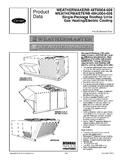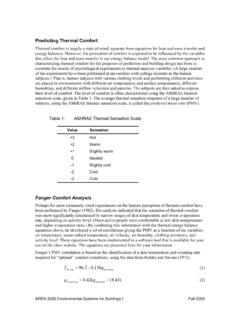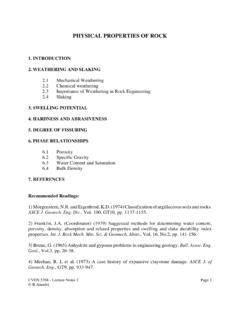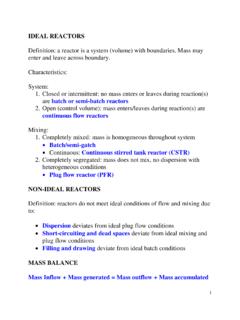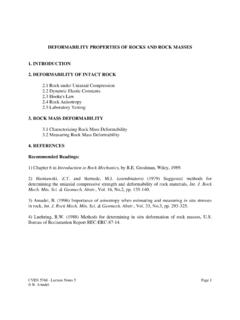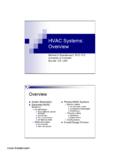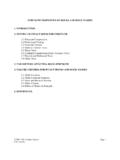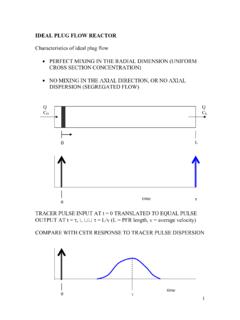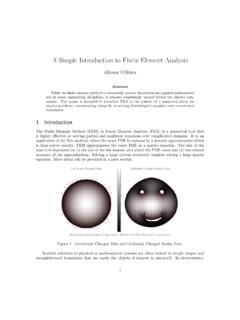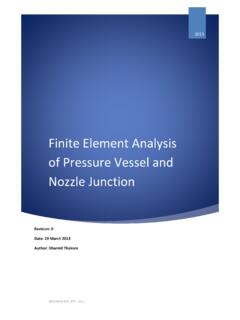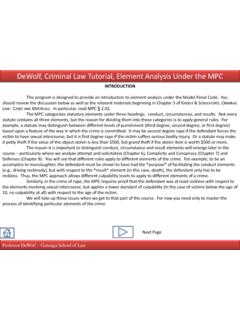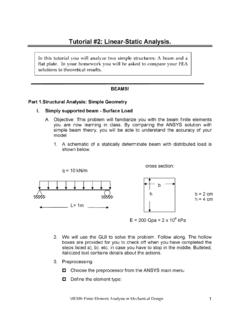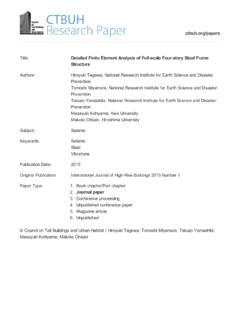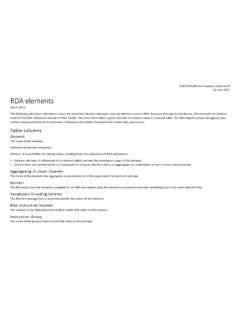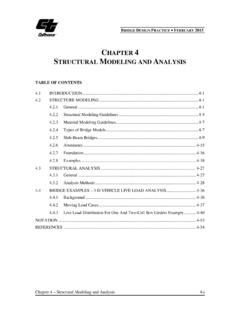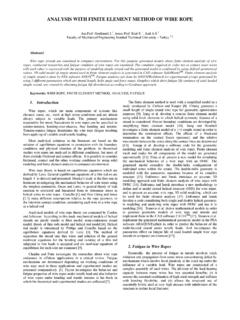Transcription of Finite Element Structural Analysis
1 1 Introduction to the Finite Element Method (FEM) CVEN 4511/5511, Fall 2019 TuTh 9:30-10:45am, ECCE 1B41 (classroom) or Bechtel Lab (ECCE 157 or 161) Instructor: Prof. Richard Regueiro, office hours: M,W,Th 11am-12pm, Tu 12-2pm, ECOT 421 Course Description: The course covers theory and application of the linear, static and dynamic, Finite Element (FE) method for continuum mechanics. We will work through, in detail, the formulation of Finite Element equations for a 1D, linear, axially-loaded bar: differential equation (strong form), integral or variational equation (weak form), discrete approximation of weak form (Galerkin form), and the Finite Element equations (matrix form to solve numerically). We will derive shape functions and discuss numerical integration.
2 We will formulate and integrate numerically in time the 1D elastodynamics equations for transient dynamic Analysis and discuss modal Analysis . We will study briefly 2D Structural frame Analysis from the FE perspective (see CVEN 4525/5525 for more details). We will study linear heat conduction and linear elastostatics for 2D and 3D boundary value problems, respectively. Proper use of Finite elements and appropriate prescription of boundary conditions will be discussed. Matlab (and maybe Python) will be used to program and solve Finite Element equations for simple boundary value problems. You will complete assignments and a project using (i) the Finite Element Analysis (FEA) software package ABAQUS , or (ii) a theoretical project involving formulation and coding of linear Finite Element equations of your choosing.
3 You will learn to use the ABAQUS UMAT and UEL (user subroutines coded in Fortran or C). Usage of ABAQUS will be covered in separate Bechtel Lab sessions during class time. Also, time permitting, we will learn to use the FEniCS project , which allows automated solution of partial differential equations using FEM. Course Objective: To obtain sufficient understanding of the theory of the linear Finite Element method and its practical application in order to use commercial Finite Element software knowledgably, or develop your own linear Finite Element code for analyzing continuum mechanics (or Structural mechanics) problems. Prerequisites: CVEN 3161 and APPM 2360, or equivalent; introductory Structural mechanics and mechanics of materials, linear algebra, some basic coding experience.
4 Matlab (or Python) is useful. Review the tutorials on webpage if you are unfamiliar with Matlab. Mathematica can also be useful for analytical derivations (such as integration) and has its own short 10 minute tutorial when opened. *The course is taught at the graduate 5000 level. Each problem set and exam will have additional or different problems for 5511 students versus 4511 students. The in-class midterm exam will be different for 4511 and 5511 students. There is no final exam for 4511 students, but 5511 will have an in-class final exam. Primary Reference: course notes in slide format posted on Other books on reserve in the Engineering Library (with optional readings): - Bathe, Finite Element Procedures, Prentice-Hall, 1995. (reference on linear and nonlinear FEM) - Cook, Malkus, Plesha, Witt, Concepts and Applications of Finite Element Analysis , 4th Edition, John Wiley & Sons, 2001.
5 (broad overview of linear and nonlinear FEM) - J. Fish & T. Belytschko, A First Course in Finite elements , Wiley, 2007 (brief, concise, treatment of linear FEM) - Hughes, The Finite Element Method: Linear Static and Dynamic Finite Element Analysis , Dover, 2000. (detailed treatment of the mathematical theory of linear static and dynamic FEM) - Zienkiewicz, Taylor, Zhu, The Finite Element Method: Its Basis and Fundamentals, Seventh Edition, Elsevier, 2013. (encyclopedia on Intro FEM by two of the fathers of FEM) Course Organization: (subject to change) (1) Theory and programming of FE equations: Fish & Belytschko (F&B), Hughes (H), Notes posted One-dimensional bar (F&B Ch 3, 4, 5; H , Sect. , , Sect. , ; of Notes): strong form, weak form, Galerkin approximation, Finite Element shape functions and equations; convergence and completeness; boundary conditions; multi- Element assembly; natural coordinate and spatial numerical integration; dynamics and temporal numerical integration (Newmark s method); modal Analysis Two-dimensional Structural frames (time-permitting) (F&B , 10; H ; Notes): Bernoulli-Euler beam Finite Element formulation; superposition of bar and beam Finite Element matrix equations into frame Element ; rotated Element ; 2D frame Analysis ; dynamics Two-dimensional linear heat conduction (F&B Ch 6, 7, 8; H Sect.)
6 , Sect. , Sect. ; Notes) and analogy to groundwater flow: strong form to Finite Element equations; triangular and quadrilateral elements ; isoparametric elements and spatial numerical integration; multi- Element assembly; Analysis of simple thermal problems; analogy to groundwater flow; temporal numerical integration of parabolic equations (generalized trapezoidal rule) 2 Two- and three-dimensional linear elastostatics and dynamics (F H Sect. , Ch3, Sect. , Sect. , , Sect. , ; Notes): general three-dimensional, plane stress, plane strain, and axisymmetric formulations; hexahedral Element ; temporal numerical integration of hyperbolic equations (Newmark s method); modal Analysis (2) Solving problems with ABAQUS (interspersed throughout the course, and for Project) Project: The project report will be due during the final exam period, and you will deliver a short 5min presentation of your results.
7 Maximum 2 students per team. You will be required also to meet with Dr. Regueiro in order to have your project idea approved. The objective of the project is to expose you to a Finite Element Analysis experience using a commercial program ( , ABAQUS) that you may encounter while working in your research group, at a national lab, or at an engineering design and Analysis firm, or to expose you to a research-oriented Finite Element programming experience (in Matlab, Python, UEL/UMAT Fortran, FEniCS, or your own code, etc.). Those interested in more theoretical aspects of the FEM may choose to do the theoretical/programming project with the approval of Dr. Regueiro. Course Grading: (for 4511 students, the final exam % is combined with the problem set %) Problem sets, including computing assignments with Matlab and ABAQUS 40% In-class Midterm Exam (date TBD, 2hr exam held in the evening) 20% Final Project 20% In-class Final Exam (date TBD) 20% Rules for Problem sets and Matlab (or Python) computing assignments: -One problem set is allowed 1 week late.
8 Otherwise, no late problem sets will be accepted past the first 5 minutes of class when the problem set is due. -You can work together on problem sets (including computing with Matlab) but must hand in your own solutions. You are encouraged to try the problems yourself before working with other students. This will help you prepare for the in-class midterm and final exams. -Your solutions must be written clearly by hand, or typeset with an equation editor, such as MS Word, MathCad, Latex, etc. If your solutions are illegible because of poor handwriting, points will be deducted. -You must turn in a hardcopy version of your problem set solutions. Rules for In-class midterm and final exams: -The in-class midterm and final exams are Open Book, Open Notes. You are allowed to bring your laptop with electronic version of lecture notes, handouts, etc.
9 , but phones must be turned off. You can bring hardcopies of handouts and problem sets too. Honor Code: Please refer to the following webpage: *Any violation of the Honor Code (such as copying verbatim a fellow student s problem set solutions, or cheating on the in-class midterm exam) will result in an immediate assignment of final letter grade of F in the course. Special considerations: -If you have a disability and require special accommodations, please provide Dr. Regueiro with a letter from Disability Services outlining your needs. Refer to the webpage -If you have a conflict as a result of religious observances, please notify Dr. Regueiro at least 2 weeks in advance of the exam or assignment due date. Access to Bechtel Lab: email (Andraa Von Boeselager) the following information: (1) your name, (2) photo of your Buff OneCard, and (3) that you are enrolled in CVEN 4511 or 5511.
10 If you already have Buff OneCard access to the Bechtel Lab, you do not need to sign up again. Your identikey username and password will allow you to login to the computers. Matlab and ABAQUS are installed on these machines. Webpage: Zoom information for Remote access to lectures real-time: - Meeting ID: 125-253-825 - Join via web browser: - Join via Zoom app (using meeting ID) - Join via One tap mobile: +16699006833,,125253825# or +16465588656,,125253825# - Join via telephone: 1-669-900-6833 or 1-646-558-8656 For more information, visit the OIT Zoom website.
